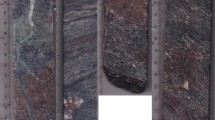Abstract
During the mining operation, ore sorting and directing different grade ores to different processing circuits is a manual task in most of working mines, but this work puts a step forward toward automation of this process. The radical development in the area of image and data processing allows speedy processing of the full color digital images for the preferred investigations. In this paper, an approach has been proposed to classify the ores for blast furnace feed, based on the visual texture of the ore particles. The visual texture of ore particles vary with the mineral contents, for example, blue dust, hard ore, soft ore, etc. This information can be quantified by using image processing technique in red, green, and blue color space and first- and second-order statistical analysis. Commonly used Hartlics textural features were calculated along with red, green, and blue color values for 5 × 5-pixel size windowpanes extracted from five separate images. Results obtained show encouraging accuracy to apply the approach to develop an expert system for online ore quality monitoring to control the ore blending in the feed ore circuits as well as separating gangue minerals present in the feed ores. Matlab 6.5 was used for visual textural analysis and classification.
مجردة
أثناء عملية التعدين ، وخام الفرز وتوجيه الصف خامات مختلفة لمعالجة مختلف الدوائر المهمة هو دليل في معظم المناجم العاملة. ولكن هذا العمل يضع خطوة إلى الأمام نحو أتمتة هذه العملية. تطوير جذري في مجال معالجة الصور والبيانات يسمح للمعالجة السريعة لون الصور الرقمية الكاملة لتحقيقات المفضل. في هذه الورقة نهجا وقد اقترحت لتصنيف خامات تغذية لالفرن العالي ، على أساس الملمس البصرية للجسيمات الخام. نسيج البصرية للجسيمات خام تختلف مع محتويات المعدنية مثلا الغبار الأزرق ، وخام الثابت ، يمكن أن كمية خام الناعمة الخ هذه المعلومات باستخدام تقنية معالجة الصور في RGB لون الفضاء ، والأول والثاني من أجل التحليل الإحصائي. يشيع استخدامها Hartlics السمات التكوينية حسبت مع الأحمر والأخضر والأزرق قيم اللون لمدة 5 × 5 بكسل وحجم النوافذ المستخرج من خمس صور منفصلة. النتائج المشجعة التي تم الحصول عليها تظهر دقة لتطبيق نهج لتطوير نظام خبير لخام على الخط لرصد نوعية للسيطرة على مزج خام في دوائر خام تغذية ، وكذلك فصل الغث المعادن الموجودة في خامات تغذية. ماتلاب 6.5 كانت تستخدم لتحليل التكوينية البصرية والتصنيف.






Similar content being viewed by others
References
Autio J, Lukkarinen S, Rantanen L, Visa A (1999) The classification and characterisation of rock using texture analysis by co-occurrence matrices and the hough transform. In: Proc. of Geo-vision 99. International Symposium on Imaging Applications in Geology, Belgium, 6–7, pp 5–8
Barbery G, Leroux D (1986) Prediction of particle composition distribution after fragmentation of heterogeneous minerals influence of texture. In: Hagni RD (ed) Process Mineralogy VI. The Metallurgical Society, Warrendale, pp 415–427
Barron L, Smith ML, Prisbrey K (1994) Neural network pattern recognition of blast fragment size distributions. Part Sci Technol 12:235–242
Haralick RM, Shapiro LG (1992) Computer and robot vision, vol 1. Addison-Wesley, Reading
Haralick RM, Shanmugan K, Dinstien I (1973) Textural features for image classification. IEEE Trans Syst Man Cybern, SMC 3(6):610
Henley ICJ (1983) Ore-dressing mineralogy—a review of techniques, applications and recent developments. Spec Publ Geological Society South Africa 7:175–200
Jones M, Horton R (1979) Recent developments in the stereological assessment of composite (middlings) particles by linear measurements. In: Jones MJ (ed) Proc. XIth Commonwealth Mining and Metallurgical Cong, IMM, London, pp 113–122
Koizumi F, Kunugita E, Nishitani H (1994) Image processing for quality/process control of polymer process. In: Proceedings of Process Systems Engineering, pp.747–752
Lin DL, Miller JD (1993) The development of a PC, image-based, on-line particle-size analyzer. Miner Metall Process 2:29–35
Moolman DW, Aldrich C, Van Deventer JSJ, Stange WW (1994) Digital image analysis as a tool for on-line monitoring of froth flotation plants. Miner Eng 7(9):1149–1164
Petersen K, Aldrich C, Vandeventer JSJ (1998) Analysis of ore particles based on textural pattern recognition. Mineral Engineering 11(10):959–977
Petruk W (1991) An image analysis and materials balancing procedure for evaluating ores and mill products to obtain optimum recoveries. In: Proc. 23rd Ann. Meeting Canadian Mineral Processors. CIM, Ottawa, Canada, p 19
Unser M (1986) Sum and difference histograms for texture classification. IEEE Trans Pattern Anal Machine Intell 8:118–125
Weszka JS, Dyer CR, Rosenfeld A (1979) A comparative study of texture measures for terrain classification. IEEE Trans Syst Man Cybern 6:269–285
Author information
Authors and Affiliations
Corresponding author
Rights and permissions
About this article
Cite this article
Singh, V., Singh, T.N. & Singh, V. Image processing applications for customized mining and ore classification. Arab J Geosci 4, 1163–1171 (2011). https://doi.org/10.1007/s12517-010-0125-2
Received:
Accepted:
Published:
Issue Date:
DOI: https://doi.org/10.1007/s12517-010-0125-2




